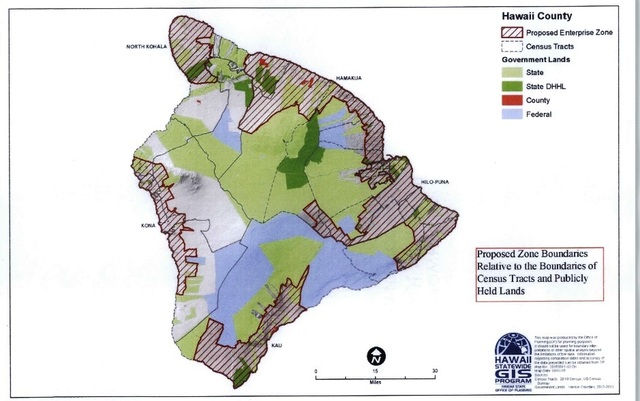Opposition from some County Council members has resulted in a scaled-back enterprise zone plan that doesn’t swallow up large conservation areas in West Hawaii. ADVERTISING Opposition from some County Council members has resulted in a scaled-back enterprise zone plan that
Opposition from some County Council members has resulted in a scaled-back enterprise zone plan that doesn’t swallow up large conservation areas in West Hawaii.
The council in March rejected an enterprise zone plan offered by county administration. A new plan, Resolution 283 sponsored by Hilo Councilman Dennis “Fresh” Onishi, was advanced by the Committee on Governmental Relations and Economic Development on a 9-0 vote Tuesday.
The revised plan came after council members met separately with Jane Horike, economic development specialist with the county Department of Research and Development.
“Jane did a good job cutting it back,” said Kohala Councilwoman Margaret Wille. “(But) I would have eliminated all conservation areas.”
Enterprise zones give substantial tax incentives for businesses willing to locate in economically depressed areas. The 20-year zones are set by the state upon application by the county.
Zones in North Kona, Hamakua and Hilo-Puna expired Oct. 1. The Ka‘u zone expired May 1, and the South Kona zone continues until April 1, 2016.
The new plan joins the North and South Kona zones together, but no longer extends them mauka into conservation lands. The Hamakua zone would extend mauka, however, as would the Puna-Hilo zone.
State officials said the county can still control where businesses are located through its zoning and other local codes.
Wille and Hamakua Councilwoman Valerie Poindexter took issue with the state’s relaxing the rules to no longer require agricultural enterprises to create jobs. Instead, they must show a 2 percent gross revenue increase in order to qualify for the program.
“We’re going backward here,” said Poindexter. “We’re helping the corporations make money off the backs of our local people who are struggling.”
“Anytime you give somebody a benefit, someone else pays for that,” Wille said.
Horike said the 2 percent option rather than employment growth was added to help support family farms who don’t have many employees.
Representatives from Big Island Abalone Corp., Hamakua Macadamia Nut Co. and Hamakua Mushrooms urged the committee to pass the measure, citing their own successful experience with the zones.
“I can honestly say it has made the difference in Hamakua Mushrooms being a successful business today,” said owners Robert and Janice Stanga in written testimony. “New businesses are very challenging and the financial tax benefits allowed through the enterprise zone would be greatly appreciated and needed by new future businesses. I hope the expansion of the enterprise zone can be provided for future businesses like ours.”
Richard Schnitzler of Hamakua Macadamia Nut Co., said his business grew from three employees to 60, coming from Kawaihae, North Kohala, Waikoloa, Hilo, Waimea, Honokaa and Kailua-Kona.
The program assisted about 300 manufacturers, wholesalers and agricultural enterprises on the island since its inception in 1994, according to Horike. She said that’s resulted in $116 million revenue and accounted for 600 jobs, she said.
“I think it has created jobs here,” Horike said.
Hilo Councilman Aaron Chung wanted to be sure the program was a benefit to the county’s economy and not just a benefit to business.
“Is it just about guys getting tax breaks?” Chung asked.
Businesses opening in enterprise zones pay no general excise tax for the first seven years. In addition, they get an 80 percent state income tax credit the first year, which drops by 10 percent annually until it reaches 20 percent the seventh year. Agricultural enterprises get 20 percent for another three years after that.
All types of qualified businesses also benefit from county property tax breaks on improvements to their property.
“We need to make the hard decisions,” said Onishi, “either on economic development and more jobs, or restricting development and dealing with more social problems.”



